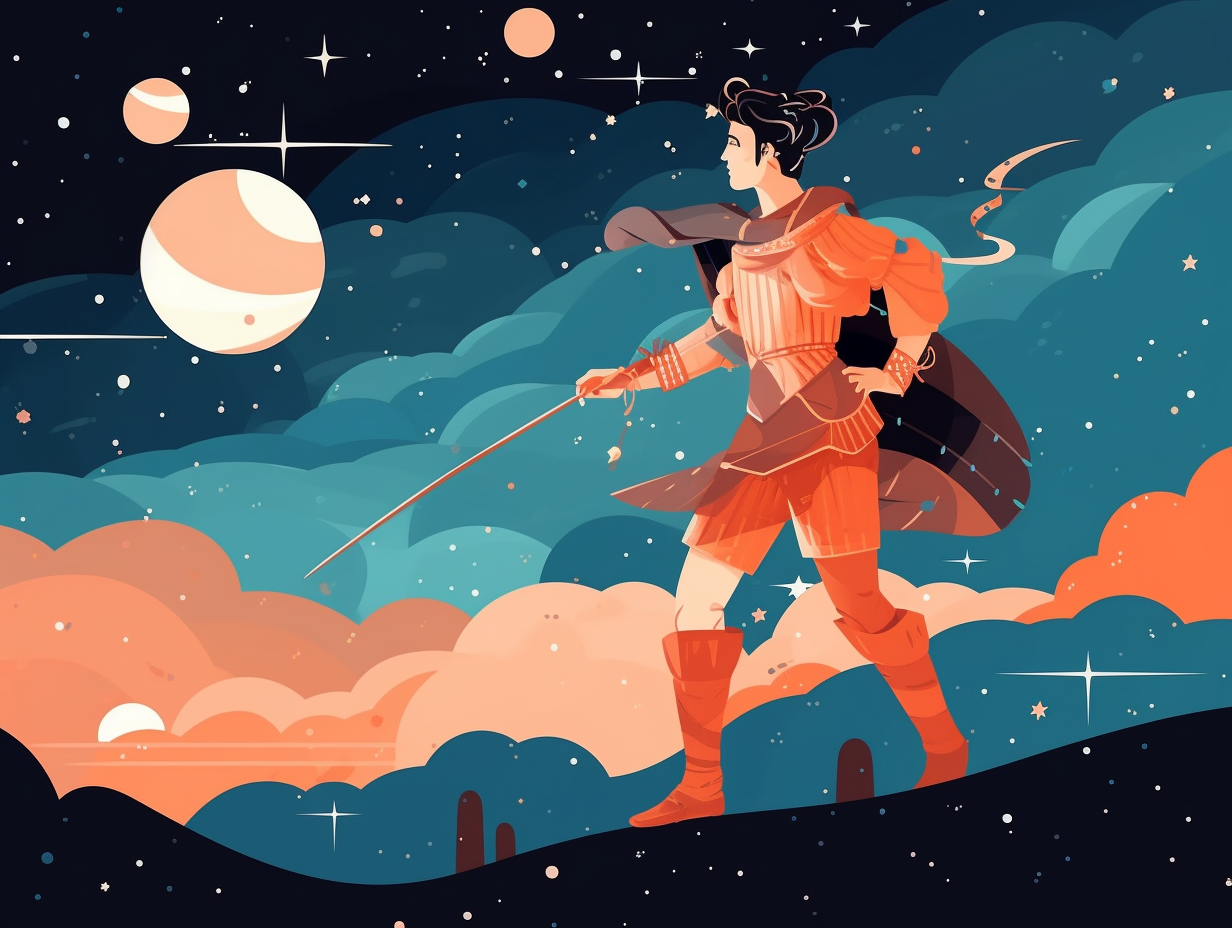Discover the Cosmos: Top 15 Fascinating Fun Facts About the Perseus Constellation

1. Celestial Double Feature
Hold onto your telescopes, skygazers – Perseus Constellation contains the ultimate celestial double feature, a celestial blockbuster if you will: This dazzling constellation boasts the spellbinding Double Cluster and the radiant California Nebula, while also playing host to the unpredictable Algol, an eclipsing binary star that's been captivating astronomers for centuries.
Source => ontarioparks.com
2. Perseus' Light Show & Demon Sidekick
Perseus might seem like a timid neighbor amongst the celestial royalty, but it loves throwing parties with its very own light show and even has a demon as its sidekick: The constellation boasts the intriguing variable star Algol, also known as the Demon Star, which appears to "wink" in the sky due to its binary components eclipsing each other, and is also the radiant of the spectacular Perseid meteor shower, delivering a stunning display of up to 100 meteors per hour during its peak.
Source => space.com

Did you know stars change colors as they heat up and cool down, with red stars being cooler and blue stars being the hottest? Discover their unique life-cycles and how they strut their cosmic style on the color wheel!
=> Fun Facts about Stars
3. Perseus: The Celestial Buffet of Wonders
Next time you're stargazing, don't forget to look up Perseus - or as we like to call it, the "celestial buffet of wonders": This constellation brims with remarkable sights, like the easily-found Alpha Persei Cluster nestled between Cassiopeia and Auriga, the slightly elusive Double Cluster hanging out above Perseus' head, and the picturesque California Nebula, which might play hard-to-get for the naked eye but looks fabulous in astrophotographs.
Source => learnthesky.com
4. Starstruck by Medusa's Gaze?
Feeling a bit "starstruck" by Medusa's infamous gaze? Good news: you'll live to see another day as her head resides well up in the night sky as Algol, the "Demon Star" whose brightness had people’s heads spinning like a Greek tragedy: In actuality, this cosmic luminary in the Perseus constellation owes its fluctuating radiance to an eclipsing binary system, where components Beta Persei Aa1 and Beta Persei Aa2 orbit, and occasionally eclipse, each other every 681 Earth days.
Source => theplanets.org

5. Algol: Celestial Drama Queen
Once upon an ominous night, the Perseus constellation threw a star-studded party, and its most scandalous guest, Algol (aka the Demon's Head), had a very public face-off – but fear not, no stardust was spilled: In reality, the Algol star system is an eclipsing binary, which means its brightness fluctuates as one star passes in front of the other, and despite its eerie reputation, modern astronomers leverage this system to study binary stars and unravel the mysteries of stellar evolution.
Source => en.wikipedia.org
6. Desperate Housewives of the Cosmos
It's a celestial case of neighbors with the starriest of feuds; think "Desperate Housewives" of the cosmos, only involving Greek myths instead of TV drama: Despite the connection between Cassiopeia and Perseus in mythology, the two constellations hold court in separate quadrants of the night sky, each with its own distinct origins and lore. Curiously, both can be spotted in a friendly celestial tête-à-tête from latitudes north of 35°N, giving stargazers in the Northern Hemisphere a double dose of astronomical royalty.
Source => en.wikipedia.org
7. Perseus & Medusa's Galactic Battle
In a celestial twist worthy of a blockbuster sequel, the Perseus constellation found itself embroiled in an epic battle of the stars, thanks to its namesake hero's (literally) head-turning victory over Medusa: The constellation is linked to the legendary story of Perseus, who decapitated the snake-haired Gorgon, Medusa, and used her petrifying gaze to vanquish foes. Some stars in this heavenly assemblage even adopt character names from the tale – such as Algol, symbolizing Medusa's eye – though, rest assured, no interstellar hand-me-downs from Perseus have been discovered thus far.
Source => theoi.com
8. Algol: The Rebellious Drummer
If Perseus were a rock band, Algol would be the rebellious drummer known as "Demon's Head," turning heads and dropping jaws with its unpredictable pulsing performances: Perseus is home to the badass binary star system, Algol, famous for its dramatically fluctuating brightness, while Alpha Persei, a yellow-white supergiant, strums with its glittering posse in the Alpha Persei Cluster.
Source => en.wikipedia.org
9. Algol: The Temperamental Star Diva
Ever heard of a star that's more temperamental than a reality TV diva? Enter Algol, the celestial drama queen: This star in the Perseus constellation is actually a prototype of a group of eclipsing binary stars called Algol variables, aptly named after the Arabic term for "The Demon's Head". At a distance of 92.8 light-years away from Earth, Algol puts on quite a show with its regular dimming and brightening, thanks to its two stars playfully eclipsing one another and causing noticeable variations in its brightness.
Source => en.wikipedia.org

10. Mirfak: Celestial Superstar
In a galaxy not so far away, there's a celestial superstar that outshines all of its galactic groupies in the Perseus constellation: enter Mirfak, the only navigational luminary in its star-studded band! This solo chart-topper is the dazzling centerpiece of the Alpha Persei Cluster, a fresh-faced open star cluster easily spotted through cosmic binoculars, and boasts a whopping five thousand times more luminosity than our very own solar superstar, the Sun, along with a mass of 8.5 Sun-sized units.
Source => star-facts.com
11. Divine Gadgets for Gorgon Omelette
Before you go losing your head over that gutsy Greek myth of Perseus and Medusa, let's talk strategy: you can't make a great Gorgon omelette without some divine gadgets and a side of sneaky reconnais-sandals: Perseus, aided by Athena and Hermes, acquired the cap of invisibility, winged sandals, and a kibisis (a magical, all-holding bag) to behead Medusa without looking at her or turning to stone.
Source => greekmythology.com
12. Perseus' Cosmic Comedy Show
They say stars can't laugh, but Perseus is definitely trying to crack up the night sky with its mesmerizing cosmic comedy show: This celestial headliner boasts not only stunning deep sky objects like the Double Cluster and the California Nebula, but also features the enigmatic variable star Algol, as if it's waiting for a celestial punchline.
Source => constellation-guide.com
13. OG of Night Sky Celebrities
Before there were star-studded blockbusters and A-listers in Hollywood, there was a true OG of night sky celebrities rocking the cosmic red carpet: Meet the ancient Perseus constellation! : This lavish figure in the celestial theater dates back to Babylonian times, sprawls over a whopping 615 square degrees, and boasts the fabulous blue supergiant Mirfak among its stellar lineup.
Source => ontarioparks.com
14. Perseus' Romantic Celestial Jewelry
While Perseus must have been quite the romantic, impressing the celestial ladies with his dazzling collection of celestial jewelry: the Perseus constellation boasts a treasure trove of deep sky objects such as the Double Cluster, the California Nebula, and the Little Dumbbell Nebula, along with the famous variable triple star system, Algol, Beta Persei, which is among the most well-known stars in the night sky.
Source => constellation-guide.com

15. Perseid Meteor Shower & Comet Debris
If ancient Greek hero Perseus ever tried to participate in a meteor shower cleaning duty, he'd be chasing the wrong trail: The Perseid meteor shower, named after his constellation, is actually the result of debris from the 109P/Swift-Tuttle comet, discovered in 1862 by Lewis Swift. Orbiting the sun every 133 years, this comet is the proud parent of the meteor extravaganza that has skywatchers in the Northern Hemisphere giddy with anticipation as they catch sight of up to 90 colorful meteors per hour during the peak days of August 11, 12, and 13.
Source => earthsky.org
Related Fun Facts




















